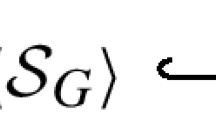Abstract
We initiate a new line of investigation on branching problems for generalized Verma modules with respect to reductive symmetric pairs \( \left( {\mathfrak{g},\mathfrak{g}'} \right) \). In general, Verma modules may not contain any simple module when restricted to a reductive subalgebra. In this article we give a necessary and sufficient condition on the triple \( \left( {\mathfrak{g},\mathfrak{g}',\mathfrak{p}} \right) \) such that the restriction \( {\left. X \right|_{\mathfrak{g}'}} \) always contains simple \( \mathfrak{g}' \)-modules for any \( \mathfrak{g} \)-module X lying in the parabolic BGG category \( {\mathcal{O}^\mathfrak{p}} \) attached to a parabolic subalgebra \( \mathfrak{p} \) of \( \mathfrak{g} \). Formulas are derived for the Gelfand–Kirillov dimension of any simple module occurring in a simple generalized Verma module. We then prove that the restriction \( {\left. X \right|_{\mathfrak{g}'}} \) is generically multiplicity-free for any \( \mathfrak{p} \) and any \( X \in {\mathcal{O}^\mathfrak{p}} \) if and only if \( \left( {\mathfrak{g},\mathfrak{g}'} \right) \) is isomorphic to (A n , A n-1), (B n , D n ), or (D n+1, B n ). Explicit branching laws are also presented.
Similar content being viewed by others
References
C. Benson, G. Ratcliff, A classification of multiplicity free actions, J. Algebra 181 (1996), 152–186.
И. Н. Бернштейн, И. М. Гельфанд, С. И. Гельфанд, Об одной каmегорuu \( \mathfrak{g} \) -модулей, Функц. анализ и его прилож, 10 (1976), no. 2, 1–8. Engl. transl.: I. N. Bernshtein, I. M. Gel’fand, S. I. Gel’fand, Category of \( \mathfrak{g} \) -modules, Funct. Anal. Appl. 10 (1976), no. 2, 87–92.
N. Conze-Berline, M. Duo, Sur les représentations induites des groupes semisimples complexes, Compositio Math. 34 (1977), 307–336.
T. J. Enright, F. Willenbring, Hilbert series, Howe duality and branching for classical groups, Ann. Math. (2) 159 (2004), 337–375.
J. C. Jantzen, Einhüllende Algebren Halbeinfacher Lie-Algebren, Ergebnisse der Mathematik und ihrer Grenzgebiete (3), 3, Springer–Verlag, Berlin, 1983.
T. Kobayashi, Discrete decomposability of the restriction of \( {{\text{A}}_\mathfrak{q}}\left( \lambda \right) \) with respect to reductive subgroups II–micro-local analysis and asymptotic K-support, Ann. Math. (2) 147 (1998), 709–729.
T. Kobayashi, Discrete decomposability of the restriction of \( {{\text{A}}_\mathfrak{q}}\left( \lambda \right) \) with respect to reductive subgroups III–restriction of Harish-Chandra modules and associated varieties, Invent. Math. 131 (1998), 229–256.
T. Kobayashi, Multiplicity-free theorems of the restrictions of unitary highest weight modules with respect to reductive symmetric pairs, in: Representation Theory and Automorphic Forms, Progress in Mathematics, Vol. 255, Birkhäuser Boston, Boston, MA, 2008, pp. 45–109.
T. Kobayashi, Visible actions on symmetric spaces, Transformation Groups 12 (2007), pp. 671–694.
T. Kobayashi, B. ∅rsted, P. Somberg, V. Souček, Branching laws for Verma modules and applications in parabolic geometry, Part I, in preparation.
T. Matsuki, The orbits of affine symmetric spaces under the action of minimal parabolic subgroups, J. Math. Soc. Japan 31 (1979), 331–357.
T. Matsuki, Orbits on affine symmetric spaces under the action of parabolic subgroups, Hiroshima Math. J. 12 (1982), 307–320.
R. Richardson, G. Röhrle, R. Steinberg, Parabolic subgroup with abelian unipotent radical, Invent. Math. 110 (1992), 649–671.
W. Schmid, Die Randwerte holomorphe Funktionen auf hermetisch symmetrischen Raumen, Invent. Math. 9 (1969–70), 61–80.
D. Vogan, Associated varieties and unipotent representations, in: Harmonic Analysis on Reductive Groups (Brunswick, ME, 1989), 315–388, Progress in Mathematics, Vol. 101, Birkhaüser Boston, Boston, MA, 1991, pp. 315–388.
Author information
Authors and Affiliations
Corresponding author
Additional information
Partially supported by Institut des Hautes Études Scientifiques, France and Grantin-Aid for Scientific Research (B) (22340026), Japan Society for the Promotion of Science.
Rights and permissions
About this article
Cite this article
Kobayashi, T. Restrictions of generalized Verma modules to symmetric pairs. Transformation Groups 17, 523–546 (2012). https://doi.org/10.1007/s00031-012-9180-y
Received:
Accepted:
Published:
Issue Date:
DOI: https://doi.org/10.1007/s00031-012-9180-y
Keywords and phrases
- branching law
- symmetric pair
- Verma module
- highest weight module
- flag variety
- multiplicity-free representation



